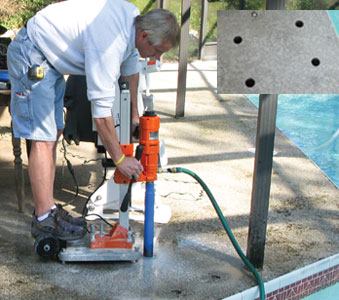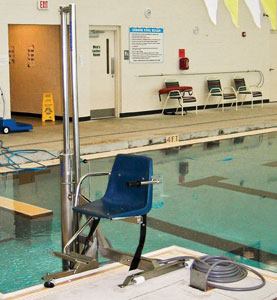Last year, the Americans with Disabilities Act was codified to spell out exactly what requirements public pools and spas need to meet in order to become compliant with the law.
The act applies to all public pools, new and existing. This includes nearly all commercial pools and spas, with the primary exception being apartment and condominium pools, which are governed by the Fair Housing Act, and registered landmarks. pools must come into compliance by March 15, 2012.
The ADA mandates that most vessels have at least one primary form of access — for pools, a lift or sloped entry; for spas, a lift, transfer wall or transfer system. Pools measuring more than 300 perimeter feet must have a second means of access, which can include a lift, ramp, transfer wall, transfer system or stairs. (There are a few exceptions, noted in the ADA standard. Click here for a link to the law.)
For many, adding a lift will be the simplest way to comply. Read on to find out how to best select and install these products on existing commercial pools and spas to make them ADA-compliant.
Menu of options
When helping the client select a lift, the decision should be guided by budget and how the unit will be used. Property owners can choose between three basic models: portable, removable and permanent. Lifts can be fueled by water or a battery and each has its benefits and drawbacks.
Portable lifts can be wheeled to various locations. When in use, the unit is steadied by a system of brakes and weights to counter the user’s mass. There is no installation other than minor assembly, which makes these models the quickest and easiest to get going. They are, however, the most expensive to purchase, and they weigh several hundred pounds, so it takes a fairly strong person to move one alone.
Removable lifts can be pulled out of a sleeve embedded in the deck. This allows some versatility, as the chair can be moved out of the way when operators know it will not be used; or it can be taken to another sleeve for use at a different spot in the pool or a different vessel altogether.
“If you have swim competitions, for instance, you’re not going to want something permanently mounted in the deck and in the way,” says Craig Sears, owner of Sears Pool Management Consultants Inc. in Sandy Springs, Ga. “You may have a referee who needs to be walking up and down the deck.”
A cap covers the sleeve and sits flush with the deck so it doesn’t present an obstruction.
By contrast, a permanent lift stays in place once it’s set, often attached to an anchor buried in the deck. This is most appealing when the unit will be used often or if the client is trying to save money, as they are the least expensive.
However, both removable and permanent lifts require installation of an anchor or sleeve in the deck, which adds cost. “On paver decks, you have to pour quite a substantial concrete ballast,” says Alvaro Mendoza, president of Commercial Energy Specialists in Jupiter, Fla. “It wouldn’t just be an anchor, it would be almost a concrete substructure. That does bring the cost a lot closer.”
Each power-source option also has its own benefits and drawbacks. For those who want a portable model, there is no choice — it must be battery-powered. When considering a removable or permanent unit, facilities owners must weigh the choices.
Water-powered lifts rely on hydraulic pressure to move the chair up and down. Some like the reliability — all that must be maintained is proper water pressure, and there is no threat of batteries dying. This may also be the choice for those who prefer to keep electricity away from the pool whenever possible.
However, getting water to these lifts requires either running a garden hose across the deck or installing permanent lines. A booster pump may also be added to maintain the needed level of pressure. Historically, many owners have opted for the hose, but some advise against it, citing a tripping hazard. “Here, the health department doesn’t allow obstructions on the pool deck, so you couldn’t just run a hose across the deck,” Mendoza says. Some codes also require that excess water released from these systems be piped away from the pool, he adds.
Battery-powered lifts run off a 24-volt, rechargeable unit that manufacturers say will last four to five years with proper maintenance. They don’t require as much drilling into the existing deck — however, some professionals would rather keep electricity away from the water, and others don’t like the idea of having the battery die.
Installation
When it comes to installation, portable lifts, as expected, are the most simple. The product is basically pre-assembled by the manufacturer, and the contractor only needs to set the brake and place the counter weights to steady the unit.
Installing either type of lift takes more time, but it isn’t difficult for those who have experience with other products attached to the deck, like starting platforms and ladders. The main requirement is knowing how to embed the anchor or sleeve into the concrete.
The anchor or sleeve must be positioned so that the chair will clear the coping or gutter — manufacturers can advise on exact placement. Also, the deck should be at least 4 inches thick, to provide proper support and accommodate the anchors, which are generally that long. “Otherwise, it’s really not enough to stabilize the lift,” says Richard Pentoney, Florida distribution representative for Aqua Creek Products in Missoula, Mont.
(If the deck measures less than 4 inches thick, use the guidelines outlined here.)
There are two ways to set anchors and sleeves: dual epoxy or cement. Be sure to consult the manufacturer’s instructions to see if one is more appropriate than the other.
To follow the epoxy method, core drill a hole just large enough for the anchor or sleeve to slip through while maintaining the tightest fit possible. “You can’t use epoxy if you’re making a 2-inch hole for a 1-1/2-inch anchor,” Pentoney says. “That’s too much space. It needs to be a tight fit for the epoxy to hold.”
Stop drilling as soon as the bit has gone through the concrete. Otherwise, the drill may damage plumbing lines hidden beneath the deck.
Be sure the hole is plumb. Put some epoxy in the hole and on the anchor. Place the anchor in the hole, ensuring it is level with the deck. Pentoney likes to place a bolt inside the anchor to help handle it and push it all the way down. Hold it in place for a few seconds, allowing the epoxy to begin hardening.
Once the material is applied, there is a limited window of time to complete installing the anchor before the epoxy sets. In Pentoney’s area, installers generally have about eight minutes.
Cemented in place
Others prefer to concrete the anchor or sleeve into place. To do this, drill the hole so it’s a few inches larger in diameter than the anchor or sleeve. “The [sleeves I install] are usually about 2 inches in diameter,” says Richard Robert, president of Knorr Systems in Santa Ana, Calif. “You have to drill about a 6- or 7-inch hole to get the [sleeve] to set properly.”
The hole may need to be flared out at the bottom to accommodate a flange at the bottom of the sleeve or anchor and provide a thicker footing. “Imagine a side view of an old school bell,” Robert says. “That’s basically what you’re trying to duplicate. It provides for a more secure base of concrete going in to secure this little anchor.”
When installing a battery-powered lift, it’s also important at this stage to address bonding in states and municipalities that require it. (Even if not required by law, it’s a good idea.) This can prove tricky. “It’s a bit of an unknown when you dig or cut through the deck where you’re going to find part of the bonding around the pool to pick up on,” Sears says. “That could be a challenge.”
If a piece of rebar can’t be located, the contractor must find something else to bond to, such as a screen enclosure or metal water pipe.
Fasten the bonding wire to the rebar or rod, then set the anchor in place making sure it is absolutely plumb. Otherwise, the lift will tip to one side.
Then, backfill around the anchor with concrete or epoxy grout. “Obviously the anchor has to be plumb,” says John Caden, director of pool lifts for manufacturer S.R. Smith, based in Canby, Ore. “It can’t be slanted or the lift will be slanted.”
With the anchor in place, begin assembling the lift according to the manufacturer’s instructions.
More from Pool and Spa News
-
Making the Most of Borates
7 MIN READ
-
Looking Like A Million Bucks
4 MIN READ
-



